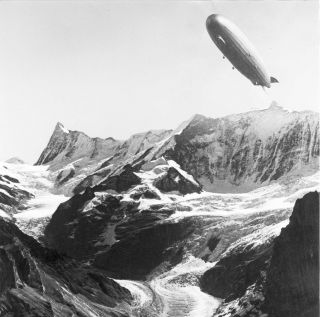On 2 July 1900 the time had come – the very first Zeppelin took off
In the bay of Manzell/Friedrichshafen Ferdinand Graf von Zeppelin and his engineer Theodor Kober watched the take-off of the 128 m long LZ 1. On its maiden flight the first Zeppelin reached a height of 400 m and covered a distance of about 6 km.
After about 30 years and many ups and downs the Zeppelin airships established the first intercontinental air traffic. The technology originating from Friedrichshafen laid the basis for modern aviation as it now belongs to everyday life. Back then it certainly was out of the ordinary, it was a very exclusive event to take off from an airship hangar out into the world. For the first time passengers, freight and, in particular mail, could travel over the ocean in one or two days. The flight in a Zeppelin – a real revolution!
The end of an era
You tend to hear and read that the Zeppelin era came to an end due to
the Lakehurst disaster on 7 May 1937. The real reason, though, can be found in
the international political development during the ye ars 1936-1940. Because of the aggressive politics of
the NS government, the USA initiated an embargo on helium, the only non-inflammable
lifting gas for airships. Consequently, there was no helium obtainable in
Germany. The LZ 129 HINDENBURG, which was originally designed for the use of
helium, had to therefore be converted to the use of inflammable hydrogen. That´s how the
disaster happened, no matter which of the many discussed causes were the reason
for the fire. The ultimate end – the dismantling of the two airships LZ 127
GRAF ZEPPELIN and LZ 130 GRAF ZEPPELIN II and the blowing up of the airship
hangars in Frankfurt – was decreed by the Nazi regime, partly because of being
hurt in their pride due to the HINDENBURG disaster, but mainly as the airships were
no good for military use and had to make way for the air force.
ars 1936-1940. Because of the aggressive politics of
the NS government, the USA initiated an embargo on helium, the only non-inflammable
lifting gas for airships. Consequently, there was no helium obtainable in
Germany. The LZ 129 HINDENBURG, which was originally designed for the use of
helium, had to therefore be converted to the use of inflammable hydrogen. That´s how the
disaster happened, no matter which of the many discussed causes were the reason
for the fire. The ultimate end – the dismantling of the two airships LZ 127
GRAF ZEPPELIN and LZ 130 GRAF ZEPPELIN II and the blowing up of the airship
hangars in Frankfurt – was decreed by the Nazi regime, partly because of being
hurt in their pride due to the HINDENBURG disaster, but mainly as the airships were
no good for military use and had to make way for the air force.
During the terrible World War II aviation technology was intensively further developed by all nations taking part in the war. After the end of the war civil aviation, of course, profited of the achieved progress. With regard to airships however, there was no further technical development, apart from the non-rigid airships which were constructed in the USA. After the war they developed into advertising blimps which we occasionally see in the sky.
